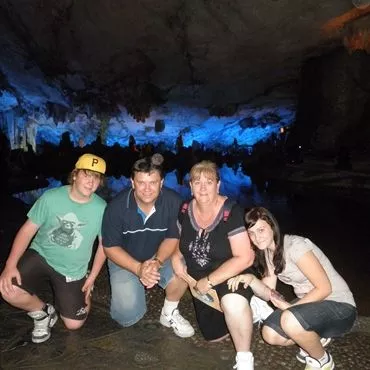Guiyang Travel Tips
Climate and Weather
Guizhou is mountainous province with subtropical climate, it is comparatively warm in winter and cool in summer, the average annually temperature is 15.6 Celsius degrees, and it is from 4-10 Celsius degrees in January and 16-28 Celsius degrees in August. Guizhou has a subtropical humid climate. There are few seasonal changes. It hasmore overcast days than any other part of the country, the area around Guiyang averaging 220 cloudy days a year.The best travel seasons are late March, April, May, August, September and October with clear days and pleasant weather.
Local Festivals and Folk Custom
Sanyuesan Festival
Sanyuesan Festival, also called the “Cutworm Fair”, is a traditional festival of the Buyi people, at which in memory of cutworms, the Buyi people scatter fried corns on the slopes and sing folk songs to pray for a bumper harvest.
Now the “Cutworm Fair” has become “Sanyuesan Song Festival”. On every 3rd day of the 3rd lunar month, the Buyi people in Guiyang and nearby gather round the Xinbao town, Wudang district. They either join in the singing competition, or sing in antiphonal style by blowing the tree leaves in the dense forest, or travel in groups along the stream playing with the water and singing cheerfully. When finding each other congenial, they will present gifts to each other and then walk in pairs from the crowds into the woods.
Liuyueliu Festival
Liuyueliu Festival is an important traditional festival of the Buyi people in Guiyang. On the 6th day of the 6th lunar month every year, thousands of the Buyi people in Guiyang and the neighboring counties gather on the beautiful banks of the Huaxi River, they enjoy themselves either going through the dense forest, or flitting from flower to flower, or going boating, or blowing tree leaves, or singing folk songs. The youngsters would take this opportunity to express their affections and love to the person of his /her heart. “Liuyueliu Song Festival” has been known in and outside Guizhou Province.
Bullfight
Not like that in Spain that it is a fight between a man and a bull, Bullfight in the rural areas of Guiyang is a distinctive amusement activity in the slack season. Bullfight is usually held after the rice shoots transplanting and before the harvest between the 6th lunar month and the 8th lunar month. The Gaopo and Mengguan two townships are the places where the Bullfight is held. The bull of the water-buffalo that is going to join in the fight is called “Balang” by the local people. To congraturate beforehand the victory of a Balang, the relatives and friends of the local or other villages will invite the owner of Balang to drink “Balang wine” to boost the courage.
Caichang which takes place on the day of bullfight is an exciting prelude. With the report of the iron crackers, the Balang, with red ribbons tied to the head, and with sheets upon sheets on its back presented by relatives and friends, should circle the court followed by the audiences. People in many other villages also bring their bulls to join the ceremony, so the atmosphere is lively and the scene is most magnificent with the spirited sound of Suona horns, the deafening noises of crackers, cheers and laughter. Then a venerable elder of the village addresses the audience and takes the gifts off the bull’s back and the ceremony “Caichang” concludes.
Before the fight formally begins, an agreement should be settled by both sides then the buffalos are escorted by the crowd on the spot and directed to rush upon its rival, fighting horn to horn. In case the two bulls are not matched in strength, soon the weak one will fall down on the ground and run away. If they are well matched, they will keep fighting until both panting and foaming at the mouth. Then a veteran will come to separate the two buffalos with something like ropes or bamboo poles to avoid casualties.
Usually a flatland in the center with gentle slops around would be chosen for the Bullfight ground, so that people can watch easily.
Siyueba Festival
Siyueba Festival is a traditional festival celebrated by Miao, Buyi, Dong, Yao, Zhuang, Yi, Tujia and Gelao peoples in Guizhou, the west Hunan and the north Guanxi. The contents and styles of celebration activities are not exactly the same in different places, of which, the most profound and far-reaching one among them is that of the Miao people in Guiyang.
On every April 8th, according to the lunar calendar, the Miao people in their best costumes in Guiyang and nearby gather around Penshuichi in the downtown of the city, to sing and dance to the melodies from the Lusheng and the bamboo flutes to celebrate their own traditional festival. Legend has it that Siyueba Festival is in memory of the ancient Miao heroes buried at the very place where Pengshuichi now lies on the 8th day of the 4th lunar month ---- “Siyueba”. This ceremony passed down from generation to generation, thus becoming a custom.
Now, this festival has become a joyous celebrated day by Miao, Buyi, Dong, Zhuang, Shui, Gelao, or even the Han people and other ethnic groups, a grand ceremony to demonstrate the traditional culture of various minority groups. Some young minority people take this advantage of the chance to make friends and choose their future spouses through their dancing and singing with deep love.
Lusheng Dance
Lusheng is an antique reed instrument. The longest one is more than 1 Zhang (a unit of length, 1 Zhang = 3 1/3 meters); while the shortest one is less than 1 Chi (a unit of length, 1 Chi = 1/3 meter). Some have a maximum of 10 reeds in one Lusheng; some have only single reed or two reeds. The most popular ones have 6 reeds, with forceful but low and deep tone or clear and melodious tone. During the long history of the development of the Miao’s culture, Lusheng has been not only regarded as the symbol of their people, but also mixed together with dance music, acrobatics and Wushu (a form of physical culture) etc. With the communication and interaction of the culture among various national ethnic groups, the Lusheng dance is also popular in Dong, Shui, Buyi, Yao and Yi people.
There are nearly 100 tunes and dance paces with the Lusheng dance, of which, 10-odd are most popular, in lively rhythm and in bold, rough and warm style. The Lusheng dance may be like this: women’s dance accompanied by men’s playing or women’s and men’s dancing accompanied by their own playing. Also Wushu activities and some extremely difficult acrobatic feats of the Miao people have been assimilated in Lusheng dance, which are especially loved by the masses. Now, the Lusheng dance has been become the necessary activity on the jubilant festivals of the Miao people in Guiyang City and in Suzhou City (Jiangsu Province).
Dixi
The origin of the Dixi can be traced back to “Nuo Dance” in the primitive society in the Chinese history. Ancestors danced with god or animal facial masks to pay tribute to gods and drive away evil spirits and pray for a harvest. “Nuoxi” show is a kind of comprehensive art transformed from the sacrificial singing and dancing ceremonies. Large number of army and emigrants to Guizhou in the Ming Dynasty brought in “Nouxi” show, which was popular in the central plains regions in the South of the Changjiang River. Later, combined with the local culture in Guizhou, Dixi was formed, which has kept the network of the original Nuoxi.
Dixi of the Buyi people in Guiyang reaches its climax on the 15th day of the first lunar month of the year. The contents of the stories are mainly based on ancient Chinese stories about going on an expedition and about loyalties, mixed with myths and legends in the rural lucky words of the local language, and also combined with drama, opera, dance opera into an organic whole. It is very interesting that the female role in Dixi should be acted by the male. The actor, covered with black cloth on his face, with a facial mask on the forehead, a war apron around the waist and dagger-axes in the hand, with magnificent and unique style of costumes, looks colorful and mysterious, which is permeated with the “indomitable courage and martial qualities of the ancient Martial Nuo”.
Other Odds and Ends
Phone Dialing Code: 0851
Postcode: 550000
Emergency Call
Fire: 119
Police: 110
Traffic alarm: 122
Local telephone inquiry station: 114
Emergency center: 120
Supervisory Office of Tourism Quality of Guizhou Province
Tel: (0851) 6892360
Hours: 8:30-11:30 14:00-17:00
Address: 346-5 Zhonghua Bei Road, Guiyang, Guizhou 550001, China
Fax: (0851) 6892309
Weather Forecast: 121
Tourism information inquiry: 6515376, 6515242
Railway inquiry service:0851-8181222
Shuttle bus inquiry:0851-6505805
Hotline for air tickets reservation (24 hours in service):0851-5977777
Airport inquiry service:0851-5983000
Passenger information desk of long-distance bus terminal:6505805
Money
Money exchange is offered in any one of the exchange counters of the Bank of China in Guiyang.
Universities
Guizhou University
Address: North School Campus, Huaxi, Guiyang, Guizhou













